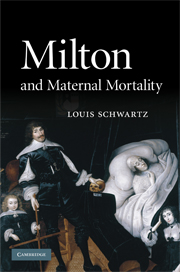Book contents
- Frontmatter
- Contents
- Acknowledgments
- Abbreviations
- Introduction
- PART I BEHIND THE VEIL: CHILDBIRTH AND THE NATURE OF OBSTETRIC ANXIETY IN EARLY MODERN ENGLAND
- 1 “Exquisitt torment” and “infinitt grace”: maternal suffering and the rites of childbirth
- 2 When things went wrong: maternal mortality and obstetric anxiety
- 3 Religious frameworks
- PART II “SCARCE-WELL-LIGHTED FLAME”: THE REPRESENTATION OF MATERNAL MORTALITY IN MILTON'S EARLY POETRY
- PART III “CONSCIOUS TERROURS”: THE PROBLEM OF MATERNAL MORTALITY IN MILTON'S LATER POETRY
- Index
- References
2 - When things went wrong: maternal mortality and obstetric anxiety
Published online by Cambridge University Press: 04 December 2009
- Frontmatter
- Contents
- Acknowledgments
- Abbreviations
- Introduction
- PART I BEHIND THE VEIL: CHILDBIRTH AND THE NATURE OF OBSTETRIC ANXIETY IN EARLY MODERN ENGLAND
- 1 “Exquisitt torment” and “infinitt grace”: maternal suffering and the rites of childbirth
- 2 When things went wrong: maternal mortality and obstetric anxiety
- 3 Religious frameworks
- PART II “SCARCE-WELL-LIGHTED FLAME”: THE REPRESENTATION OF MATERNAL MORTALITY IN MILTON'S EARLY POETRY
- PART III “CONSCIOUS TERROURS”: THE PROBLEM OF MATERNAL MORTALITY IN MILTON'S LATER POETRY
- Index
- References
Summary
Although in the majority of cases childbirth and its rites occurred predictably and with a positive outcome, the rate at which deadly or debilitating complications occured was relatively high, especially in London. The rites, in other words, were often maimed, and they were themselves designed to ward off thoughts of their own possible defeat. Fear of death in childbirth was a conscious part of peoples' lives, and it deeply affected both the ways in which they practiced the rites of the childbed and the ways in which they described and thought about those rites. This fear (for various reasons we will explore later) was, however, usually expressed in carefully managed terms. We will therefore be less subject to the pitfalls of alarm, anachronism, or exaggeration for rhetorical effect if we search for indications, not of acute terror (although examples of that do exist, especially in crisis situations), but of managed anxiety, evidence of terror being kept at bay.
Let us first look, however, at what historians have been able to tell us about maternal mortality itself and the ways in which it may have been perceived. Estimates have fluctuated over the past forty years or so, but the consensus among historians at this point is that in the course of the seventeenth century, even if rates for England as a whole were not quite as high as some earlier studies had suggested, rates in London were comparable with some of the highest rates recorded for any human community.
- Type
- Chapter
- Information
- Milton and Maternal Mortality , pp. 29 - 48Publisher: Cambridge University PressPrint publication year: 2009



